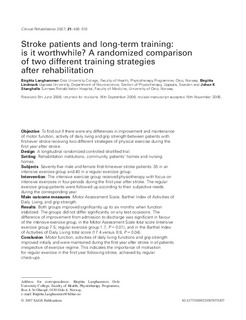| dc.contributor.author | Langhammer, B. | |
| dc.contributor.author | Lindmark, B. | |
| dc.contributor.author | Stanghelle, J.K. | |
| dc.date.accessioned | 2018-04-20T11:35:34Z | |
| dc.date.available | 2018-04-20T11:35:34Z | |
| dc.date.issued | 2007 | |
| dc.identifier.citation | Langhammer, B., Lindmark, B., & Stanghelle, J. K. (2007). Stroke patients and long-term training: is it worthwhile? A randomized comparison of two different training strategies after rehabilitation. Clin Rehabil, 21(6), 495-510. | nb_NO |
| dc.identifier.uri | http://hdl.handle.net/11250/2495293 | |
| dc.description.abstract | Objective: To find out if there were any differences in improvement and maintenance of motor function, activity of daily living and grip strength between patients with first-ever stroke receiving two different strategies of physical exercise during the first year after stroke.
Design: A longitudinal randomized controlled stratified trial.
Setting: Rehabilitation institutions, community, patients' homes and nursing homes.
Subjects: Seventy-five male and female first-time-ever stroke patients: 35 in an intensive exercise group and 40 in a regular exercise group.
Intervention: The intensive exercise group received physiotherapy with focus on intensive exercises in four periods during the first year after stroke. The regular exercise group patients were followed up according to their subjective needs during the corresponding year.
Main outcome measures: Motor Assessment Scale, Barthel Index of Activities of Daily Living, and grip strength.
Results: Both groups improved significantly up to six months when function stabilized. The groups did not differ significantly on any test occasions. The difference of improvement from admission to discharge was significant in favour of the intensive exercise group, in the Motor Assessment Scale total score (intensive exercise group 7.5; regular exercise group 1.7, P = 0.01), and in the Barthel Index of Activities of Daily Living total score (17.4 versus 8.9, P = 0.04).
Conclusion: Motor function, activities of daily living functions and grip strength improved initially and were maintained during the first year after stroke in all patients irrespective of exercise regime. This indicates the importance of motivation for regular exercise in the first year following stroke, achieved by regular check-ups. | nb_NO |
| dc.publisher | Clinical Rehabilitation | nb_NO |
| dc.subject | stroke patients | nb_NO |
| dc.subject | long-term training | nb_NO |
| dc.subject | training strategies | nb_NO |
| dc.subject | rehabilitation | nb_NO |
| dc.title | Stroke patients and long-term training: is it worthwhile? A randomized comparison of two different training strategies after rehabilitation | nb_NO |
| dc.type | Journal article | nb_NO |
| dc.source.pagenumber | 495-510 | nb_NO |
| dc.source.volume | 21 | nb_NO |
| dc.source.journal | Clinical Rehabilitation | nb_NO |
| dc.source.issue | 6 | nb_NO |
| dc.identifier.doi | 10.1177/0269215507075207 | |
